“April, April – der macht was er will” is a popular German saying meaning “April, April – does what he wants.”
Like an impish child who refuses to comply, the weather challenges us with conditions not ideal for backcountry skiing in the Alps. But instead of allowing a bad boy weather day to drag us down, we head to Innsbruck with friends for sightseeing.
Before cloudy skies pour rain, we ride the Nordpark Cable Railway for a journey through an artistic wonder. Designer Zaha Hadid, the first and only women to receive the Pritzker, the architectural equivalent of the Nobel Prize, used double curvature glass to create the lower, middle and upper railway tram stations. As fantastic as the visual design, which imitates the morphology of the Alps in winter, is the hybrid funicular’s course: beginning at the underground station in the center of the city, the railway travels through a tunnel, crosses the river and climbs an incline of 46% to reach the village of Hungerburg, 288 meters above Innsbruck, the base of the Seegrube ski area.
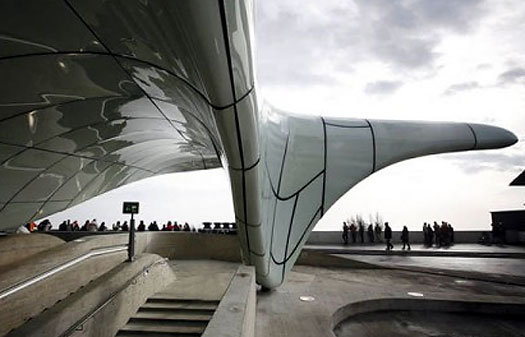
Nordpark Cable Railway. Renowned architect Zaha Hadid also designed Innsbruck's Bergisel ski jump and London's Aquatics Center which will be used for 2012 Summer Olympics.
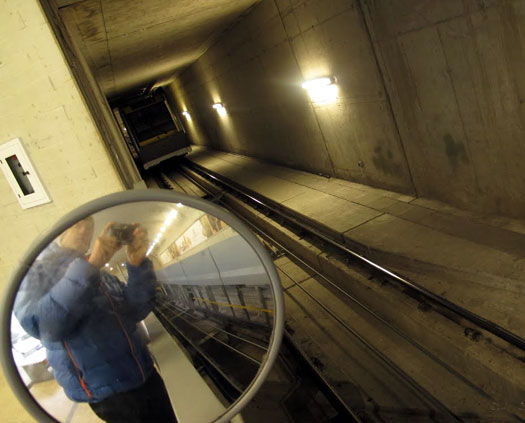
The Nordpark Cable Railway tunnel.
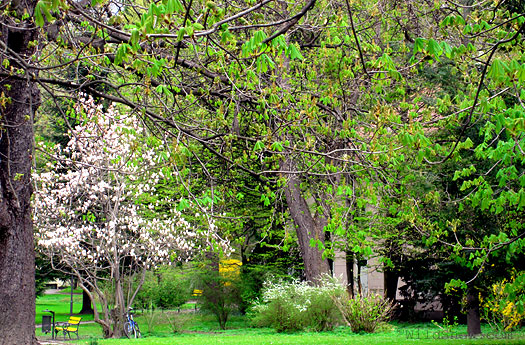
Brilliant greens of spring, a park near the Nordpark Cable Railway.
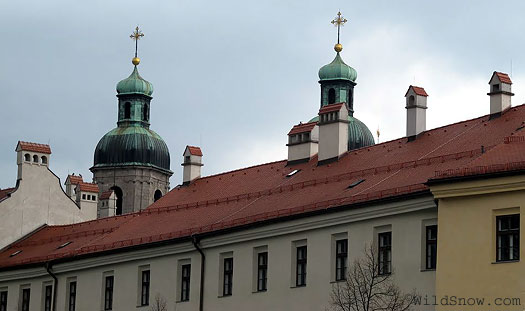
Steeples along the Inn River
Our next stop is the Innsbruck Hofburg which houses the Alpenverein-Museum, owned and operated by the Austrian Alpine Club (ÖAV). The venue is called “bergauf – 150 Jahre Alpenverein” (150 years of alpinism). We enter to find the the first room full of spectacular paintings of the mountains. Edward Theodore Compton’s work is particularly stunning.
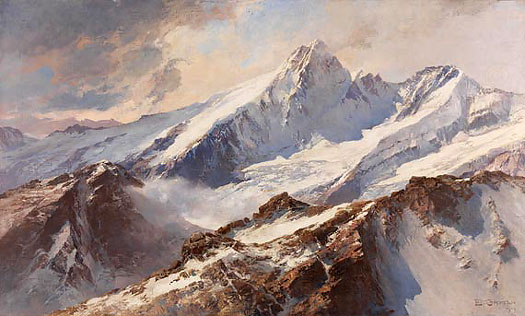
Grossglockner by Edward Theodore Compton, 1898. The museum caption reads 'As an accomplished mountaineer, Compton was able to practice his art at higher altitudes than his predecessors. So as to do justice to the unique light condition's above tree line, he would seize every opportunity to hunt for colors and was always intensely pleased when he succeeded in bagging new hues.'
The deep blue hue of a mountain sky has always intrigued me, so I was delighted to find a cyanometer on display. Invented by Geneva naturalist Horace Benedict de Saussure in the 18th century, it analyzes the relationship between altitude and the blue of the sky. He produced a simple set of graduated blue color cards by adding different quantities of black and white, and used them to determine the turbidity of the sky caused by dust and water vapor–the darker the blue, the clearer the air. During the last century, high cyanometer readings were used to attract tired city-dwellers to alpine resorts.
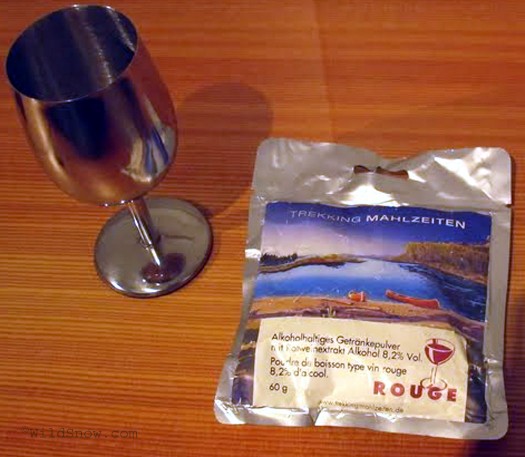
For years mountaineers have longed for dehydrated wine and beer. It appears the Austrians already had it.
Other exhibits at the museum include: A room devoted to hut culture, complete with soundtrack of a guy snoring in a lager; numerous historical maps and photos; Innsbruck native Hermann Buhl’s boots from his first ascent of Nanga Parbat — as well a Pervitin (commercial methamphetamine of the 1950s) vial that could have possibly been from that same trip.
Thoroughly famished after a few hours of cultural stimulation, we walk outside, through the old part of town in search of wiener schnitzel.
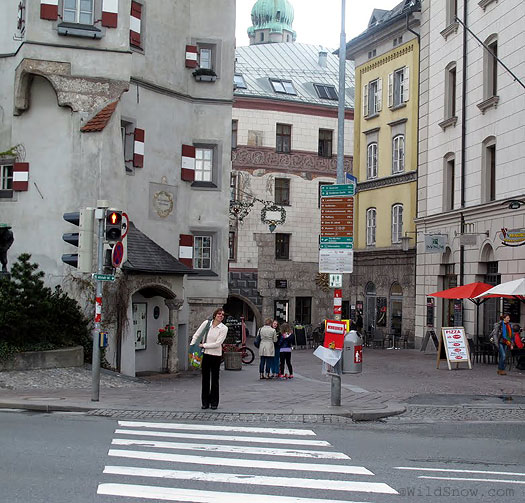
Lisa outside the Ottoburg
The Ottoburg appears. Built in 1473, this is one of the oldest houses Innsbruck. The two children of emperor Maximilian lived there after their mother died in a horse accident. A Gothic tower, it contains several floors with small rooms, all beautifully renovated. It is a museum that smells like a 5-star restaurant. We climb the stairs to a quiet room on the third floor and choose a table with views of the the Inn River.
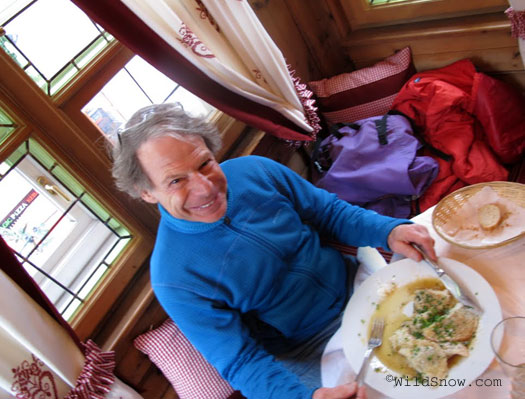
Life is good at the Ottoburg.
Ted is thrilled to find Schlutzkrapfen on the menu. A traditional Tirolean dish of ravioli filled with spinach, he has been craving this delectable entree after we devoured it at the Bella Vista Hut. A gourmet cook, he promises to make it for us during our next visit to Jackson Hole. To hold him to it, I wrangle the recipe:
Schlutzkapfen (slippery pockets)
Dough
2.5 cups flour
1.5 cups water
Mix enough flour and water to make a dough that isn’t sticky, knead for 5 minutes. Let sit while filling is prepared. Roll flat on a floured surface then cut into circles using a large glass.
Filling
1 pound fresh spinach, chopped
1/2 onion, finely chopped
1 tablespoon butter
1 clove garlic, minced
4 oz. fresh ricotta, drained well
1 heaping tablespoon grated parmigiano
1/8 teaspoon grated nutmeg
salt and pepper
Steam spinach. Squeeze out excess water. Saute onions in butter until fragrant. Add the spinach and remaining ingredients; mix well. Season to taste with salt and pepper.
Place a teaspoon of spinach mix into each dough circle and fold in half. Mash the edges together, forming a pocket.
Bring water to boil in a large pot. Toss in a few pockets, and boil for about five minutes until the noodle is cooked well.
Serve with olive oil, grated Parmesan and a sprinkle of salt and chives.
Wunderbar! I believe Lou and I will be heading up to Jackson Hole soon.
For more information about the Austrian Alpine Club Museum, click here.
WildSnow Girl, Lisa Dawson, is the luckiest girl in the world. Also known as Mrs. WildSnow.com, she tests whatever gear she wants. She gives the WildSnow family of websites the feminine voice.
